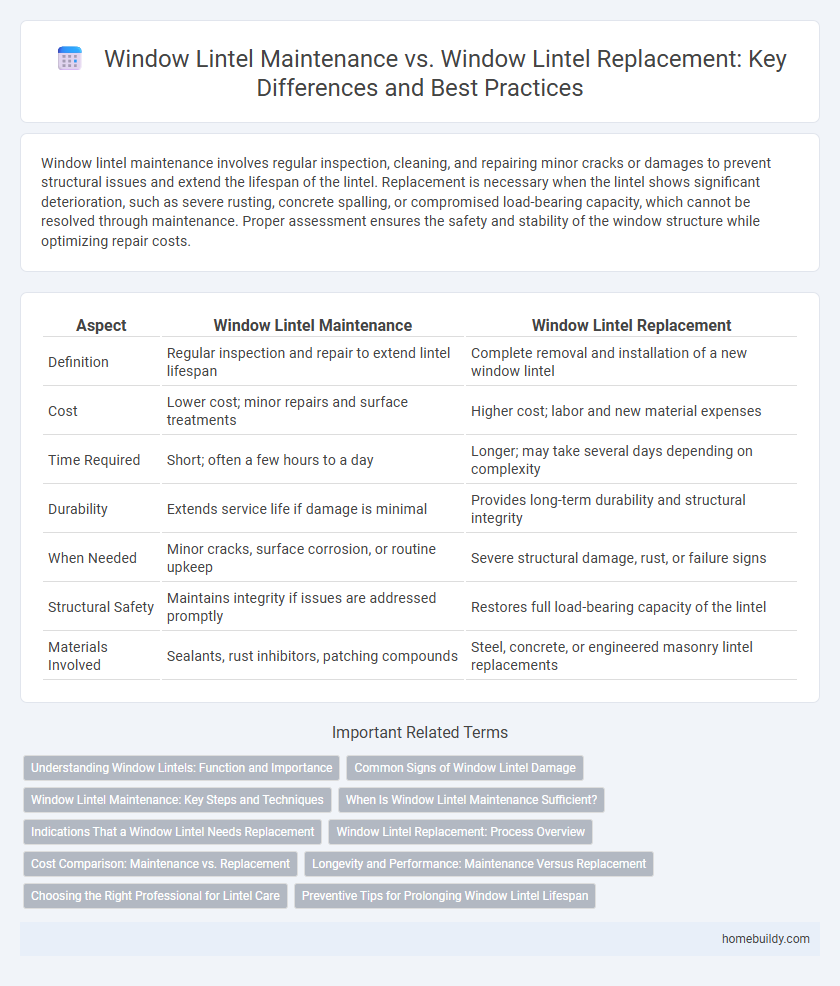Window lintel maintenance involves regular inspection, cleaning, and repairing minor cracks or damages to prevent structural issues and extend the lifespan of the lintel. Replacement is necessary when the lintel shows significant deterioration, such as severe rusting, concrete spalling, or compromised load-bearing capacity, which cannot be resolved through maintenance. Proper assessment ensures the safety and stability of the window structure while optimizing repair costs.
Table of Comparison
| Aspect | Window Lintel Maintenance | Window Lintel Replacement |
|---|---|---|
| Definition | Regular inspection and repair to extend lintel lifespan | Complete removal and installation of a new window lintel |
| Cost | Lower cost; minor repairs and surface treatments | Higher cost; labor and new material expenses |
| Time Required | Short; often a few hours to a day | Longer; may take several days depending on complexity |
| Durability | Extends service life if damage is minimal | Provides long-term durability and structural integrity |
| When Needed | Minor cracks, surface corrosion, or routine upkeep | Severe structural damage, rust, or failure signs |
| Structural Safety | Maintains integrity if issues are addressed promptly | Restores full load-bearing capacity of the lintel |
| Materials Involved | Sealants, rust inhibitors, patching compounds | Steel, concrete, or engineered masonry lintel replacements |
Understanding Window Lintels: Function and Importance
Window lintels serve as crucial structural supports above window openings, bearing the load from the wall above and preventing cracks or sagging. Regular maintenance of window lintels includes inspecting for rust, cracks, and water damage to extend their lifespan and ensure structural integrity. Replacement becomes necessary when lintels show severe corrosion or deformation, compromising safety and potentially leading to costly wall repairs.
Common Signs of Window Lintel Damage
Common signs of window lintel damage include visible cracks, rust stains, and sagging above the window frame, indicating structural weakness. Maintenance involves sealing minor cracks and applying rust-resistant coatings to prolong the lintel's lifespan. Replacement is necessary when damage compromises load-bearing capacity, causing noticeable deformation or falling debris.
Window Lintel Maintenance: Key Steps and Techniques
Window lintel maintenance involves regular inspection for cracks, rust, or water damage to ensure structural integrity and prevent costly replacements. Key techniques include sealing gaps with waterproof caulking, repainting to protect against corrosion, and reinforcing with steel plates or epoxy injections when minor damage is detected. Timely maintenance extends the lifespan of window lintels, preserving the stability of the surrounding masonry and reducing the need for full replacement.
When Is Window Lintel Maintenance Sufficient?
Window lintel maintenance is sufficient when small cracks, minor surface rust, or slight spalling are present, and the structural integrity remains intact. Routine inspections and timely repairs such as patching mortar or applying anti-corrosion coatings can extend the lintel's lifespan effectively. Replacement becomes necessary only when extensive corrosion, significant cracking, or load-bearing failure compromises the lintel's stability and safety.
Indications That a Window Lintel Needs Replacement
Signs indicating a window lintel requires replacement include visible cracks, significant rust on steel components, and sagging above the window frame. Water damage or spalling concrete that compromises structural integrity also necessitates replacement rather than simple maintenance. Early detection of these issues is critical to prevent further damage to the surrounding masonry and ensure safety.
Window Lintel Replacement: Process Overview
Window lintel replacement involves carefully removing the damaged lintel and installing a new support beam, ensuring the structural integrity of the wall above the window. The process includes securing temporary supports, excising the old lintel without compromising surrounding masonry, and fitting a new lintel crafted from steel, concrete, or wood, depending on the building requirements. Proper installation restores load-bearing capacity, prevents cracks and sagging, and extends the lifespan of the window structure.
Cost Comparison: Maintenance vs. Replacement
Window lintel maintenance typically involves minor repairs such as sealing cracks, repainting, or reinforcing supports, with average costs ranging from $100 to $500 depending on lintel size and damage severity. In contrast, window lintel replacement is a more extensive and costly process, often costing between $1,000 and $3,000 due to labor-intensive removal and installation, including potential structural reinforcements. Choosing maintenance over replacement can significantly reduce expenses in the short term, but frequent repairs may accumulate higher costs over time compared to the long-term solution provided by full replacement.
Longevity and Performance: Maintenance Versus Replacement
Regular maintenance of window lintels, including cleaning and inspecting for cracks or corrosion, significantly extends their longevity and ensures optimal structural performance. When deterioration such as severe rust, spalling, or deformation occurs, replacement becomes necessary to prevent compromised load-bearing capacity and potential window frame damage. Choosing between maintenance and replacement depends on the lintel's material condition and age, with proactive maintenance delaying costly replacements and preserving building integrity.
Choosing the Right Professional for Lintel Care
Selecting a qualified structural engineer or masonry specialist ensures precise assessment of window lintel integrity and appropriate maintenance strategies. Regular inspections paired with expert repairs can extend the lifespan of a window lintel, preventing costly replacements. Opting for experienced professionals minimizes risks of structural damage and guarantees compliance with safety standards during both maintenance and replacement.
Preventive Tips for Prolonging Window Lintel Lifespan
Regular inspection and timely repair of minor cracks, rust, or water damage significantly extend the lifespan of window lintels. Applying protective coatings and ensuring proper drainage prevents corrosion and structural weakening. Replacing deteriorated lintels is necessary only when maintenance cannot restore their integrity and load-bearing capacity.
window lintel maintenance vs window lintel replacement Infographic

 homebuildy.com
homebuildy.com